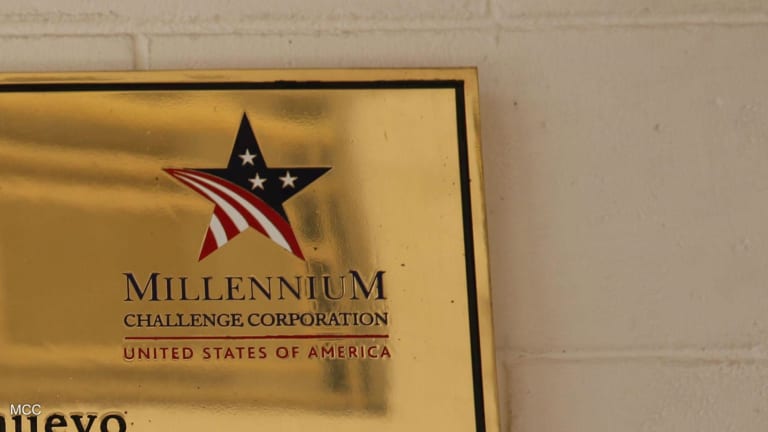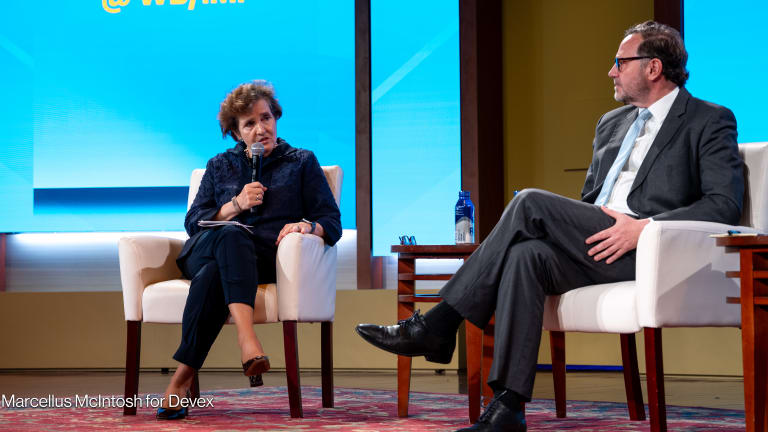
WASHINGTON — Jonathan Nash’s tenure at the Millennium Challenge Corporation has been dynamic. What began with the stress of a startup ended with the challenge of navigating the 15-year-old agency through a tumultuous period of change.
Nash joined MCC in 2006, not long after the agency was created. He worked first on a road project in Honduras, but stepped into a variety of leadership positions in the past decade. For the last two years he has, on and off, led the agency in an acting capacity as it awaits a U.S. Senate-approved CEO. Wednesday was his last day.
“It's irresponsible as a donor to go out there and connect to more customers if you haven't fixed the source problem. That's where MCC's thinking has evolved ... we're much better at taking kind of a sectorwide approach.”
— Jonathan Nash, acting CEO, MCCThe past two years have been trying for MCC, which has come under fire for the number of political appointees the White House has placed within its ranks and undergone scrutiny from Congress about partisan and discriminatory comments from former interim leader Robert Blau.
After a string of short-term acting CEOs and Nash’s own stint in the role, he handed the reins to Cynthia Huger, who will be the agency’s fourth interim leader in two years, on Jan. 31.
As Nash prepared to leave — he will join Blumont as chief strategy officer and vice president for development — he sat down with Devex to share how MCC has gone from “a bold experiment” to a data-driven agency looking to expand how and where it works.
Unrealistic expectations
Nash joined MCC in 2006 when the agency was trying to figure out how to live up to the ambitious vision set out when it was created.
“We literally were building the plane and flying it at the same time and there are people in Congress and outside saying fly it faster, fly higher. Why isn't your plane bigger?” Nash said.
The initial vision for MCC was to spend about $5 billion a year on compacts with countries that met certain governance criteria, with the expectation that it should only take a couple months to design the deals. The board selected 16 countries for compacts for the first cycle. But the expectations for the agency, which employed 18 people at the time, were unrealistic, Nash said.
“There were these really unrealistic expectations around what MCC could accomplish,” Nash said. “The idea that we're going to be pumping out 5 billion dollars a year, the math just doesn't work right given how we were set up.”
Those initial estimates of what MCC might be able to distribute were unrealistic, both because there is a limit to how much money a country can absorb in a given period of time and only so many countries MCC can work with, Nash said. Today, the pool of countries where MCC can work is even smaller, shrinking as more countries, particularly in Latin America, have graduated from low- or lower-middle-income status.
But while MCC has never achieved the size initially envisioned, the core ideals or tenets of the model — that it is data-driven, that the agency works with the best governed of the poor — have stayed constant over the years. What’s changed is how the agency does the work, Nash said.
Designing amid chaos
Nash has seen the agency evolve in a number of ways: how it publishes data, how it selects countries for compacts, how it works with partners, and, most recently, an expanded ability to consider regional compacts.
MCC has gotten better at how it presents its data, Nash said, making it more accessible to people who want to use it to understand what works. The agency has also improved at designing the compacts and then executing right away, rather than launching them before they were ready, and it is more rigorous in project selection and evaluation, Nash said.
“I think it's amazing that despite the kind of chaos at the beginning we still were able to design and implement programs that were effective,” Nash said, adding that not all of them were.
There were assumptions and mistakes in those early compacts, many of which were road projects, he said: “We kind of assumed that the government had the ability to maintain those roads over time,” Nash said.
That often wasn’t the case, he added. About five years after he started, MCC changed the way it did road projects, working with governments to set up a road or maintenance fund so that there was a dedicated stream of revenue for maintenance. That emphasis on policy and institutional reform is a key part of how the agency has transformed. Today, some projects focus exclusively on addressing policy and regulatory challenges.
“You rarely find grant money in the amount that we offer for your policy and institutional reforms,” Nash said. “Most countries don't want to borrow money to reform their subsectors and laws ... So that's something else that's really different, the importance of policy and institutional reform and our willingness to fund that has also increased over the years.”
In the early days, MCC “missed some opportunities” to work with partners, including other development institutions and the private sector, but that’s another place where the agency has grown: “There were some projects where we kind of worked more independently than we should have. But now ... partnerships is kind of central to how we think about things,” he said.
Nash points to the second Ghana compact, which combined MCC funds, a private sector power operator, and commitments from companies to build power plants once reforms were implemented, as an example of this approach to partnership. It also represents part of another shift in MCC’s tactics — taking a sectorwide view.
“My personal view is that it's irresponsible as a donor to go out there and connect to more customers if you haven't fixed the source problem,” Nash said. “That's where MCC's thinking has evolved just in terms of we're much better at taking kind of a sectorwide approach.”
New leader and new tools
Acting as the agency’s CEO was the honor of his career, Nash said, despite the tumultuous time he oversaw.
“This has been an unprecedented time for MCC over the last couple of years,” Nash said. “In the history of the agency, we have not gone this long without a Senate-confirmed CEO.”
Nash acknowledged the turmoil and said multiple leadership transitions created a difficult environment for staff. Public scrutiny about how many political appointees were working at the agency added to the chaos. Nash did his best to address staff needs and to speak up when things happened “that weren’t right or weren’t aligned with MCC’s values,” he said.
Ideally, a CEO picks a team to help lead the agency. Without one, the agency faced a different scenario — one where the White House made hiring decisions. Nash was reserved in his comments to Devex about the revolving door of interim CEOs and the number of political appointees: “Those decisions were White House decisions,” he said.
The agency has continued to deliver, Nash added, bringing nearly $2 billion in programs to its board for approval. Still, he emphasized the importance of the agency having Senate-confirmed leadership.
“We have held back on what I think are some big decisions or strategic directions that I think the incoming CEO will need to think through,” Nash said, including about how to use its threshold authority and how it will roll out its new ability to do regional compacts.
Nash said the “White House continues to have confidence in” Sean Cairncross and the administration is hopeful he will be confirmed soon.
Senators question MCC nominee on qualifications
Some in the development community have questioned the qualifications of Sean Cairncross, nominated to be CEO at MCC. Here's what he had to say in his nomination hearing.
“I think Sean will bring a lot of energy and enthusiasm and devotion to the role,” Nash
said. “He knows that the agency is full of people who are highly qualified, very competent, and I think as a leader, he's thinking through the best way to harness that and support that.”
As the agency awaits congressional action on the confirmation of the CEO, leaders have a number of decisions to make, including how it will roll out regional compacts, a new tool that Congress approved last year. MCC officials will head to West Africa in the next month to look at potential options for the first regional compact in five countries where it has had compacts.
The early regional work will be with countries that are current MCC partners, in part to prove that it works, but Nash said could it envision future projects where MCC works with partners in non-MCC countries to do a regional project.
MCC is also looking at how it might do compacts at a subnational level, something Congress asked it to explore last year. There are some key questions, including whether that would mean working with cities or regional governments, and what metrics the agency would use to select compact partners, because the scorecard it uses for country compacts wouldn’t work, Nash said.
Nash would also like MCC to further evaluate how it uses its threshold authority, or the grants it can provide countries to help them work on governance issues so they can become eligible for a compact. The board recently selected Ethiopia for a threshold program, which Nash considers an opportunity for the agency to go in and help support Prime Minister Abiy Ahmed in his reform efforts.
“There's a lot of flexibility in our statute, particularly around threshold, that we just haven't yet explored,” he said.
When Brock Bierman, who was also serving as a U.S. Agency for International Development assistant administrator, was appointed acting MCC CEO, there was some chatter in development circles about whether MCC should remain an independent agency or be folded into USAID. But MCC is more effective and efficient as an independent agency, Nash said.
“You just have two very different organizations [with] very different structures, DNA, authorities flexibilities,” he told Devex.
The agency has a strong commitment to working closely with USAID, and MCC has also been exploring how it can work more closely with the new U.S. Development Finance Corporation.
“It's not about MCC surviving, it's about how do you take this model, this tool in the foreign assistance toolkit and use it to address development challenges broadly speaking,” Nash said.








